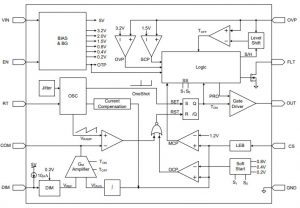Diagram note: the single LED represents a series string of LEDs.
Output regulation is based on an average current mode loop. “The special [loop] amplifier follows the design formula to combine the Ton and Toff information which are forced to be equal potential through system negative feedback,” according to the firm. Average (un-dimmed) output current is 150mV/Rcs. 150mV is the internal reference).
Max output current depends on the external mosfet selected – the data sheet does not specify gate drive current or mosfet, but does specify gate drive rise time (40ns typ, 14V supply) with a load of 1nF. One application hinted at in the data sheet (its figure 1) drives an eight LED string (~24V) at 600mA from a 12V rail.
 Switching can be adjusted across 70kHz to 700kHz by Rt, and this is jittered to spread its spectrum to reduce EMI.
Switching can be adjusted across 70kHz to 700kHz by Rt, and this is jittered to spread its spectrum to reduce EMI.
The device has a dimming pin to control output current, which can be moved from 0 to 100% using 0-1.6V dc for analogue dimming, or 0-100% PWM (0 to >2.5V swing) for digital dimming.
This pin also has a permanent 10μA source current for control by a resistor to 0V, such as an NTC thermistor.
An open-drain fault flag pin is available. Protections include: input under-voltage, output over-voltage, output short-circuit
Qualification is to AEC-Q100 across -40°C to 125°C, with H2 human body model ESD classification and device CDM ESD classification level C6.
Packaging is MSOP-10EP ( package and AEC-Q100 qualified.
Copyright © All Right Reserved 浙ICP备15016532号
BY: